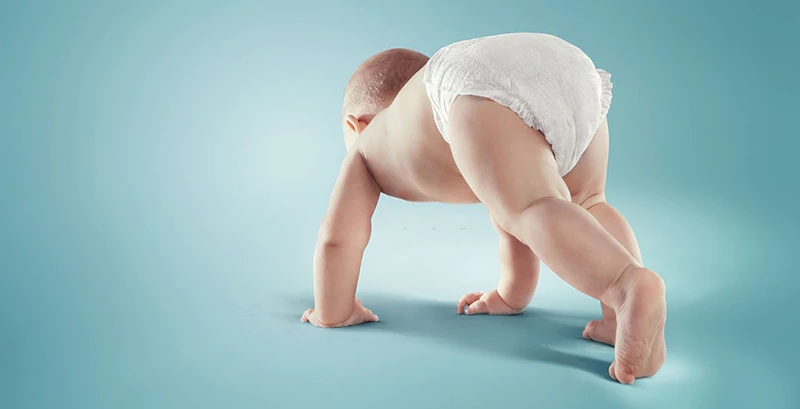As a parent, you want to make sure your child has the best possible start in life. A big part of that is making sure they develop properly and healthily. One common development issue for children is asymmetrical crawling.
It can be very confusing to see your baby’s crawls seem a little different from the others. Now you want to know everything about asymmetrical crawling.
You might be thinking, what asymmetrical crawling is and what are the underlying reasons for it- is it neurological or biomechanical in nature? How to fix asymmetrical crawling? And the list of questions goes on and on.
This blog post is all about providing you with authentic information so that you can help your child overcome asymmetrical crawling. We’ll discuss asymmetrical crawling, what causes it and how to correct it. Stay tuned for more tips on ensuring your child’s healthy development!
Characteristics of Asymmetrical Crawling
- The baby will be using one foot and one knee instead of using two knees while crawling.
- Kids will move both their right hand and foot in tandem, as well as the left.
- Both, spine and the pelvis are shifted to one side.
- Babies will use one arm and knee more to move themselves forward while the other arm and leg remain relatively idle.
- Babies develop a preference to use one hand over the other when reaching for toys or to interact with others.
What Causes Asymmetrical Crawling
Crawling is a fundamental milestone in a baby’s development. Crawling allows babies to explore their surroundings and helps them develop strong muscles and coordination skills.
When it comes to fixing asymmetrical crawling, we need to know the underlying reasons for it. Therefore, in the next section of the blog post, we will be discussing the reasons for asymmetrical crawling.
Poor Body Awareness:
Body awareness is the ability to feel and to be aware of where one’s body is in space and how the body moves. Asymmetrical crawling can be caused by poor body awareness in children.
Autism Spectrum Disorders (ASD):
In 2004, research conducted by Departments of Psychology and Child Psychiatry, University of Florida, showed that one of the sample infants who were later diagnosed with ASD exhibited asymmetrical crawling patterns. However, due to the small sample size, we would not want to link every single asymmetrical crawling case with ASD. But we really want you to consult your doctor as soon as you find your child crawling asymmetrically.
Trouble for Coordination:
asymmetrical crawling can be caused by trouble for coordination.
Asymmetry of Muscles and Hips:
The muscles on both sides of the human body should be symmetrical with each other in terms of size and strength. Any muscle imbalance or asymmetry of muscles can cause asymmetrical crawling. Also, asymmetry of the hip can be another reason.
Weak Ab and Back Muscle:
Weakness in ab and back muscle can also cause your kids to crawl asymmetrically.
Pain Avoidance Nature:
Children usually adapt to a pain-avoiding behavior where they make some adjustments to avoid pain. For example, sometimes, pain in the wrist, shoulder, or knee joints makes kids adjust their crawling style to asymmetrical crawling to avoid pain.
Sometimes children crawl asymmetrically on hard surfaces while doing normal crawling on a carpeted surface—another reflection of their pain-avoiding behavior.
Trouble in Vision:
Trouble in vision could be another reason for asymmetrical crawling. When children crawl, they are usually able to tilt their pelvis to enjoy a full range of view. However, when a child finds it difficult to look up, they tend to stick their opposing leg out to tilt the vision up while crawling- resulting in asymmetrical crawling.
Impact of Asymmetrical Crawling on Your Baby’s Development
- The child may be unaware of their true midline. This means that they could have difficulty using both sides of their body together.
- The spine continuously curves to one side, often leading to a condition called scoliosis.
- Asymmetrical crawling can lead to atypical development of future skills such as walking, running, etc.
Read more: PERMANENT NUMBNESS AFTER C SECTION: HOW TO DEAL WITH IT?
How to fix asymmetrical crawling:
Kneeling
Kneeling at a support surface or supported kneeling is a great way to strengthen your child’s hips and core. And might be particularly beneficial for fixing asymmetrical crawling. You may facilitate your children playing while kneeling to fix asymmetrical crawling. Also, letting them push forward some obstacle like a box while they are on their knees can be helpful to correct their crawling.
Side Sitting
Side sitting is an excellent way for your little one to work on balance and strengthen their hips and trunk. If they have any asymmetries or weaknesses on one side, side-sitting will help get them stronger and fix asymmetries.
Crawling over pillows or obstacles
When your little one is crawling over pillows or obstacles, it is a lot harder for them to lift that one foot up and crawl asymmetrically. So making them crawl over such surfaces can also be another way of fixing asymmetrical crawling.
Read more: Best baby gates to stop babies from crawling towards stairs.
Facilitation
Holding your child’s ankle very gently while they are crawling could be an effective way to fix asymmetrical crawling. It essentially restricts your children from using that one foot to crawl asymmetrically. Instead, it facilitates them to use the knee for crawling.
Also, when they are crawling asymmetrically, you may gently swoop that one leg back to a kneels crawling position. This technique can also be very beneficial to correct asymmetrical crawling.
But, remember weakness in the core could be one of the underlying reasons they crawl asymmetrically. So, when you apply the above techniques, your child might faceplant due to the weakness of their core.
So you should apply the above two techniques regularly but not overdo them. For example, sometimes you let them crawl asymmetrically, and sometimes you use the above techniques to correct their crawling.
And always be very while applying the above techniques.
Read More: BABY FLAILING ARMS AND LEGS WHILE SLEEPING – How to Deal With It
Sit Up
Sit-up is another effective exercise that can be very useful for your asymmetrically crawling child.
Physioball
You may use a physioball to correct the crawling pattern of your little one. Bouncing and weight shifting from side to side or forward-back are great exercises for strengthening core and muscle activation.
The information we’ve provided in this article should be enough to start you on the road towards understanding Asymmetrical crawling. If you want more, please get in touch with us and let us know how much you like our effort so far. By reading this article, we hope that parents will feel empowered to learn what causes asymmetrical crawling and how it can be fixed. Thank you for taking the time to read!
ATTENTION:
The information on this website is not intended to replace professional medical advice and should never be taken as such. Instead, it should only serve as a starting point for discussing the well-being of your little one. We highly recommend you discuss any concerns or questions regarding you and your family’s health or medical conditions with a doctor or a licensed healthcare provider.









what would you do if your 10 month old crawls with one leg out but the other is bent in front of there stomach.